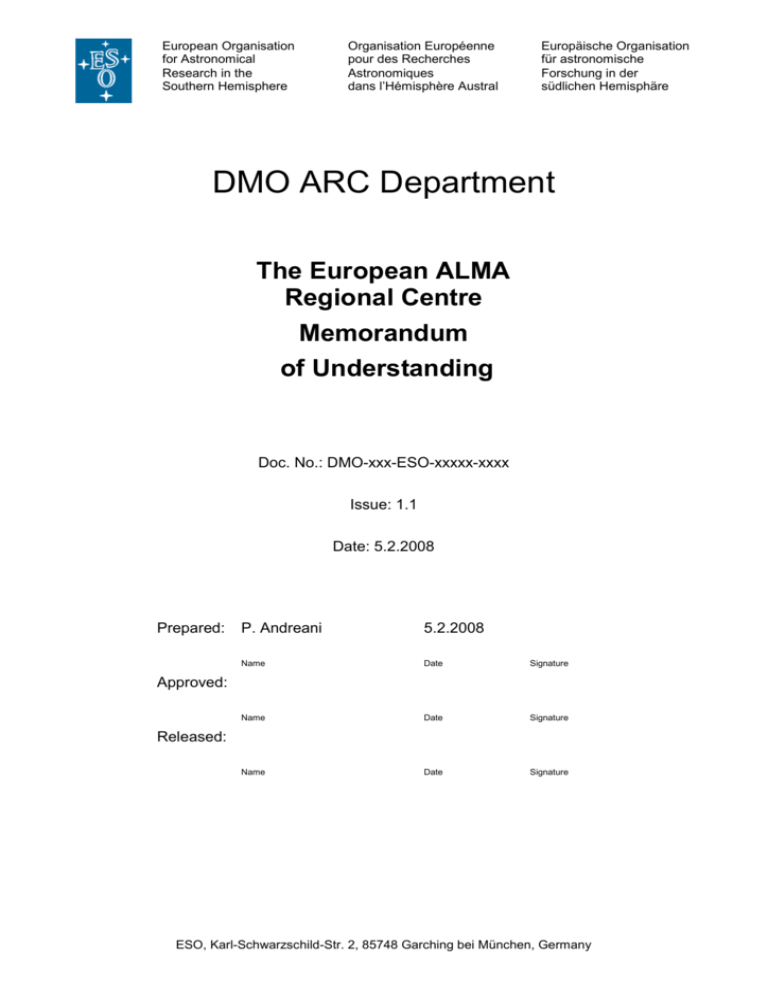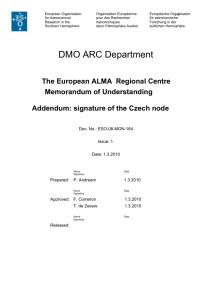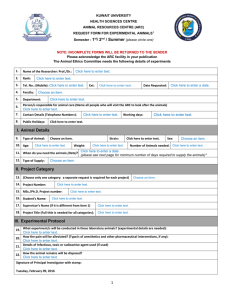ARC implementation plan
advertisement

European Organisation for Astronomical Research in the Southern Hemisphere Organisation Européenne pour des Recherches Astronomiques dans l’Hémisphère Austral Europäische Organisation für astronomische Forschung in der südlichen Hemisphäre DMO ARC Department The European ALMA Regional Centre Memorandum of Understanding Doc. No.: DMO-xxx-ESO-xxxxx-xxxx Issue: 1.1 Date: 5.2.2008 Prepared: P. Andreani 5.2.2008 Name Date Signature Name Date Signature Name Date Signature Approved: Released: ESO, Karl-Schwarzschild-Str. 2, 85748 Garching bei München, Germany ARC Memorandum of Understanding Doc: Issue Date Page DMO-xxx-ESO-xxxxx-xxxx 1 31.10.2007 2 of 13 CHANGE RECORD ISSUE DATE SECTION/PARA. AFFECTE REASON/INITIATION DOCU D MENTS/REMARKS 0.2 0.3 1.0 1.1 30/11/07 21/12/07 22/1/08 5/2/08 Introduction, Sections 5, 6, Sections 2, 4, Typos, English editing Sections 2,3 1.2 17/3/08 Sections All 1.3 6/5/08 Sections 1,2,3,4 After telecon of Dec 3rd After telecon Jan. 14th Comments by T.Wilson and F. Comeron After comments by MH, TM, FG After Simon Garrington’s comments, JB, MH RELATED DOCUMENTS ISSUE DATE NAME OF THE DOCUMENT VERSION D Oct. 9 2007 OPERATIONS PLAN 103 meeting Jun 7-8 2004 ALMA REGIONAL CENTRES Jan 2004 Charge to the RSC WG Sep 2004 Minutes of Meeting Oct 26-27 2005 Report on the European ARC VERSION A Nov. 2007 IMPLEMENTATION PLAN BODIES JAO ESO COUNCIL EU ALMA BOARD ESAC STC ESO ARC ESO, Karl-Schwarzschild-Str. 2, 85748 Garching bei München, Germany ARC Memorandum of Understanding VERSION A March 2007 Doc: Issue Date Page DMO-xxx-ESO-xxxxx-xxxx 1 31.10.2007 3 of 13 Guidelines for the ARC nodes ACC Table of Contents SCOPE .....................................................................................................................................................5 1 THE EUROPEAN ALMA REGIONAL CENTRE ..............................................................................6 2 THE ARC FUNCTIONS AND DELIVERABLES ..............................................................................6 3 DESCRIPTION OF CORE AND ADDITIONAL SUPPORT AT DIFFERENT STAGES .............7 3.1 EARLY PRE-OPERATIONS STAGE .............................................................................................................7 3.2 LATE PRE-OPERATIONS STAGE................................................................................................................8 3.3 FULL OPERATIONS STAGE .......................................................................................................................9 4 THE ORGANIZATION AND INTERACTION OF ESO ARC CORE AND THE ARC NODES 10 4.1 ESO RESPONSIBILITY............................................................................................................................. 10 ESO, Karl-Schwarzschild-Str. 2, 85748 Garching bei München, Germany ARC Memorandum of Understanding Doc: Issue Date Page DMO-xxx-ESO-xxxxx-xxxx 1 31.10.2007 4 of 13 4.2 ARC NODES RESPONSIBILITIES ............................................................................................................. 10 5 FUNDINGS ............................................................................................................................................ 11 6 RESOLUTION OF DISPUTES ........................................................................................................... 11 7 ENTRY INTO EFFECT, DURATION AND TERMINATION ....................................................... 11 SIGNATURES.............................................................................................................................................. 12 ABBREVIATIONS ...................................................................................................................................... 13 ESO, Karl-Schwarzschild-Str. 2, 85748 Garching bei München, Germany ARC Memorandum of Understanding Doc: Issue Date Page DMO-xxx-ESO-xxxxx-xxxx 1 31.10.2007 5 of 13 Scope This document is a Memorandum of Understanding (MOU) between ESO ALMA Regional Centre (ARC) Department of the Data Management and Operations Division (DMO) and the ARC nodes of (in alphabetic order): European ARC nodes Country, location Representative INAF-Bologna I, Bologna Jan Brand Bonn-Bochum-Cologne D, Bonn Frank Bertoldi IRAM F,D,E, Grenoble Frederic Gueth Allegro NL, Leiden Michiel Hogerheijde Manchester UK, Jordrell Bank Centre Tom Muxlow for Astrophysics Onsala S,DK,SF, Onsala Observatory Space John Conway This MoU covers the responsibilities of the ESO ARC (hereafter the ARC core) in coordinating the activities of the ARC nodes, delivering software provided by the JAO, and any documentation and information material related to the scope of the ARC and of the nodes, and the responsibilities of the ARC nodes in the provision of advanced software and staff effort for face-to-face user support and community development on a best effort basis. The services are described in this document and in the documents listed in section ‘Related Documents’ on page 3. It may be updated when necessary to document any official changes between the parties and when any major changes in this structure will occur. ESO, Karl-Schwarzschild-Str. 2, 85748 Garching bei München, Germany 1 The European ALMA Regional Centre The interface between ALMA and the European user communities is formed by the European ALMA Regional Centre (EU ARC), which will comprise a cluster of nodes located throughout Europe, together with a core centre located at the ESO headquarters in Garching. This core centre is part of ESO’s Data Management Operations Division (DMO). The EU ARC will be the point of contact for European ALMA users from the moment of proposal submission through to the subsequent data analysis. The core centre will be responsible for the delivery of data to principal investigators, the maintenance and refinement of the ALMA data archive, and the provision of feedback to the software relevant for ALMA science operations. It will also provide help to assist users in the submission of proposals and observing programmes. Fundamental to ALMA’s success in Europe is the high level of user support services provided by the network of ARC nodes. These are required to fully realize the transformational nature of ALMA and to maximize the scientific return for the European community. The arrangement of geographically distributed ARC nodes outside ESO for science support was approved by ESAC, STC, EAB and ESO Council (see documents in page 3). Six full ARC nodes were proposed; a seventh proposal by Portugal was for a start-up effort. Face-to-face support provided by each of the ARC nodes is open to all users, although it is expected that normally users will utilise their nearest node (or the node funded by their own country or organization). An ARC Coordinating Committee (see Section 4.1) will monitor ARC node usage and any significant imbalance in the distribution of requests for face-to-face support may result in a redirection of the requests to another node. Requests for specialised help will normally be directed to those nodes with expertise in the relevant subject areas. 2 The ARC functions and deliverables 2.1 Core functions provided by the central node The core services of the ARC at the ESO headquarters are to provide service to and coordinate user support for European astronomers, hosting and maintaining a complete mirror of the ALMA archive. The services to be provided include: Tools for proposal preparation, preparation of phase 2 materials, the delivery of the calibrated science products to the principal investigators. Full face-to-face user support is considered of fundamental importance and is a project deliverable. These core services are detailed in documents listed on page 3 (Operations Plan version D, Implementation Plan version A). ESO, Karl-Schwarzschild-Str. 2, 85748 Garching bei München, Germany ARC Memorandum of Understanding Doc: Issue Date Page DMO-xxx-ESO-xxxxx-xxxx 1 31.10.2007 7 of 13 Core services are under the responsibility of the ALMA project and the ESO ARC has to ensure that this service is delivered. ARC nodes might be subcontracted to provide part of this core service. 2.2 Additional functions provided by the nodes The distributed network of ARC nodes will provide additional services to the ALMA user community, comprising: User support, face-to-face help, Enhanced data reduction and exploitation of the archive, Development and maintenance of new software and techniques, Special projects support, Scientific community development: fellowships, user grants (where applicable), student and postdoctoral programmes, organization of workshops and schools and any other support facilities for users, and Community outreach. Any additional tasks of the ARC nodes may be the outcomes of continuous discussions between the ARC nodes and ESO. 3 Description of core and additional support at different Operations stages 3.1 Early pre-operations stage This stage refers to the period prior to the beginning of the Commissioning and Science Verification. 3.1.1 Tasks of the central node A major activity of the ARC at this stage is to test the user software system, consisting of the Observing Tool, the offline system (data reduction) and the pipeline (automatic data reduction) and the Archive. ARC core staff will be actively involved in software testing via the following projects: ESO, Karl-Schwarzschild-Str. 2, 85748 Garching bei München, Germany Participation in user tests organised by the Computing Team of the offline system, Observing Tool (OT), Pipeline, Archive, etc. In-house testing of the offline system, OT, Pipeline, Archive, etc. Organisation of “scientific processing” tests within the European user community. 3.1.2 Tasks of the nodes ARC node staff will be actively involved in offline and proposal submission software testing: Either through user training organised in consultation with the ESO ARC core. Or through user tutorials organised in consultation with the ESO ARC core. ARC staff will train the community by organizing specialized workshops dedicated to offline software and/or to ALMA observations in general. The EU ARC core is the primary point of contact for the offline software users and testers in Europe and a contact astronomer will be appointed among the ARC astronomers. S/he will be the interface between the users and the developers collecting feedback from the users and organizing them in a useful way for the developers. 3.2 Late pre-operations stage 3.2.1 Tasks of the central node This stage starts with the beginning of the Commissioning and Science Verification (CSV) and ends when the project releases the call for Early Science. A major task of ESO ARC personnel at this stage is the participation in Commissioning and Science Verification (CSV). ARC core staff will travel to Chile for extended periods of time (3 to 6 months) to help with CSV and to train other ARC astronomers – who will be hired throughout this stage – in ALMA operations. During this phase ARC core staff support software testing, review and refinement of the user documents for the Phase 1 and Phase 2 tools, as well as the offline data reduction system. ARC core staff will be involved in preparing the release of the first call for proposals (done on behalf of the JAO by the ARCs) and will prepare all material required for the support of phase 1 and phase 2 submission. All this material will be made available through the ESO ARC webpage. Finally, ARC core staff will have to provide the European community with access to the science verification data. 3.2.2 Tasks of the nodes Personnel from the ARC nodes may, subject to approval by the ALMA project Scientist, participate in Commissioning and Science Verification (CSV). This activity is coordinated by the ALMA Project scientist and in Europe by the European Project Scientist. ESO, Karl-Schwarzschild-Str. 2, 85748 Garching bei München, Germany ARC Memorandum of Understanding Doc: Issue Date Page DMO-xxx-ESO-xxxxx-xxxx 1 31.10.2007 9 of 13 ARC node astronomers are invited at ESO for regular meetings (at least once per year in this early stage and more frequently at later stages) to share information, coordinate support, documentation and to introduce any software developments related to user support. ARC nodes’ staff will organise regular workshops/tutorials to update the other nodes and ESO ARC staff with their progress in software developments. 3.3 Full Operations stage 3.3.1 Tasks of the central node The ARC operations stage begins with the Early Science Decision Point. At this point in time, the ARC will be carrying out its full core activities. The details of these activities are given in the Operations Plan and in the ESO Implementation Plan. In the remainder of this section, these core activities are listed. Phase 1 operations: call for proposals and support to astronomers preparing their proposals, assistance in coordinating the refereeing process and in assessing the technical feasibility of the proposals. Phase 2 operations: preparation of the technical details required to schedule and execute the proposed observations. Data product support: delivery of the final raw and pipeline-reduced data to the PIs. Archive operations: The ESO ARC will hold a complete synchronized copy of the ALMA archive. Feedback on operational processes and tools ARC core staff will be responsible for providing feedback to the observatory (JAO) on ALMA operational processes and tools. 3.3.2 Tasks of the nodes Face-to-face user support Advanced software developments and maintenance Advanced user support Help in archival research: assistance to users of the ALMA archive in identifying and using the data products suitable for their scientific projects Storage of advanced data products: data reduced at the nodes might be stored at the nodes or in the main ALMA archive Feedback to ESO-ARC Community development ESO, Karl-Schwarzschild-Str. 2, 85748 Garching bei München, Germany 4 The organization and interaction of the ESO ARC core and the ARC nodes 4.1 Central node responsibility The ESO ARC is the responsibility of the ARC Manager. Each of the ARC nodes nominates a representative who is responsible for its activity and the fulfillment of this MoU. In this geographical distribution of nodes, ESO ARC plays a central and coordinating role to ensure that it is effective in supporting all parts of the ESO community. In particular the ESO ARC will ensure that software development and distribution within the EU ARC is efficient. An ARC Coordinating Committee (ACC), consisting of one representative of each ARC node and chaired by the ARC manager, is set up. The ACC provides descriptions of the tasks of each node, coordinates the activities of the core and the nodes in terms of tasks and expertise areas. Staffing and budget are the responsibility of the individual nodes. Communication between the nodes is achieved through an interactive web-page (a wiki page), which is only accessible to registered users within ESO and the ARC nodes, through face-toface meetings and regular telecons. Regular visits of the ARC Manager and/or his/her deputy to the ARC nodes are scheduled once a year in the early stages and more frequently during full Operations stage. 4.2 ARC nodes responsibilities Each node agrees to carry out the tasks described in sections 2 and 3, and further detailed in the Guidelines, on a best-effort basis (see Documents on page 3). Each node will report regularly all relevant information to the EU ARC core and the other nodes, through web interfaces, telecons, and face-to-face meetings. Each node also agrees to be visited regularly by the ARC manager or her/his deputy to further ensure efficient information exchange within the EU ARC. These visits are scheduled each year in the early stages and more frequently during the full Operations stage, to ensure that homogenous service and user support are provided at each node. Each node will notify the core and the other nodes in a timely manner about any problems that arise with its compliance with this section, and ask for an ACC meeting (electronic or face-to -face) to find a solution. ESO, Karl-Schwarzschild-Str. 2, 85748 Garching bei München, Germany ARC Memorandum of Understanding Doc: Issue Date Page DMO-xxx-ESO-xxxxx-xxxx 1 31.10.2007 11 of 13 5 Funding Funding for the nodes is sought from their own national funding agencies. Additional funding proposals involving multiple nodes plus core (for instance for EU funding for networks) will be coordinated by the ACC. 6 Resolution of disputes Should any dispute arise on any matter relating to the interpretation or the implementation of this MoU, such dispute will be referred to the ACC which will seek to resolve the dispute by mutual agreement. 7 Entry into effect, duration and termination This MoU will become effective upon signature and will remain in effect until 2015 with automatic extensions with periods of three years each until the end of ALMA operations, unless otherwise notified. This MoU can be renegotiated at any time when core/additional functions are redefined or additional Parties are interested in joining the ARC network, by giving a written notice to the other Parties which will be discussed by the ACC. ESO, Karl-Schwarzschild-Str. 2, 85748 Garching bei München, Germany Signatures European ARC nodes Institutes INAF-Bologna INAF Signatures Bonn-Bochum-Cologne IRAM IRAM Leiden Manchester Onsala ARC Department at ESO European Southern Observatory Abbreviations ACA ALMA Compact Array ACC ARC Coordinating Committee ALMA Atacama Large Millimeter Array AoD Astronomer-on-Duty AOS Array Operations Site AOT ALMA Observing Tool ARC ALMA Regional Center CSV Commissioning & Science Verification EAB European ALMA Board ESAC European Science Advisory Committee ESDP Early Science Decision Point ESO European Southern Observatory FTE Full-Time Equivalent ISM International Staff Member JAO Joint ALMA Office OSF Operations Support Facility OT Observing Tool ESO, Karl-Schwarzschild-Str. 2, 85748 Garching bei München, Germany ARC Memorandum of Understanding PRC Program Review Committee STC Science and Technical Committee SV Science Verification Doc: Issue Date Page DMO-xxx-ESO-xxxxx-xxxx 1 31.10.2007 13 of 13 ESO, Karl-Schwarzschild-Str. 2, 85748 Garching bei München, Germany








